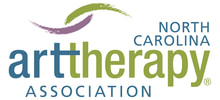Who We Are
The American Art Therapy Association, Inc. is an organization of professionals dedicated to the belief that making art is healing and life enhancing. Its mission is to serve its members and the general public by providing standards of professional competence, and developing and promoting knowledge in, and of, the field of art therapy. (AATA)
The North Carolina chapter of the American Art Therapy Association serves to support art therapists and advocate for the professional field of art therapy in North Carolina.
The North Carolina chapter of the American Art Therapy Association serves to support art therapists and advocate for the professional field of art therapy in North Carolina.
Frequently Asked Questions
What is art therapy?
Art therapy is a mental health profession in which clients, facilitated by the art therapist, use art
media, the creative process, and the resulting artwork to explore their feelings, reconcile
emotional conflicts, foster self-awareness, manage behavior and addictions, develop social skills, improve reality orientation, reduce anxiety, and increase self-esteem. A goal in art therapy is to improve or restore a client’s functioning and his or her sense of personal well-being. Art therapy practice requires knowledge of visual art (drawing, painting, sculpture, and other art forms) and the creative process, as well as of human development, psychological, and counseling theories and techniques.
Today art therapy is widely practiced in a wide variety of settings including hospitals, psychiatric and rehabilitation facilities, wellness centers, forensic institutions, schools, crisis centers, senior communities, private practice, and other clinical and community settings. During individual and/or group sessions art therapists elicit their clients’ inherent capacity for art making to enhance their physical, mental, and emotional well-being. Research supports the use of art therapy within a professional relationship for the therapeutic benefits gained through artistic self-expression and reflection for individuals who experience illness, trauma, and mental health problems and those seeking personal growth. (American Art Therapy Association)
media, the creative process, and the resulting artwork to explore their feelings, reconcile
emotional conflicts, foster self-awareness, manage behavior and addictions, develop social skills, improve reality orientation, reduce anxiety, and increase self-esteem. A goal in art therapy is to improve or restore a client’s functioning and his or her sense of personal well-being. Art therapy practice requires knowledge of visual art (drawing, painting, sculpture, and other art forms) and the creative process, as well as of human development, psychological, and counseling theories and techniques.
Today art therapy is widely practiced in a wide variety of settings including hospitals, psychiatric and rehabilitation facilities, wellness centers, forensic institutions, schools, crisis centers, senior communities, private practice, and other clinical and community settings. During individual and/or group sessions art therapists elicit their clients’ inherent capacity for art making to enhance their physical, mental, and emotional well-being. Research supports the use of art therapy within a professional relationship for the therapeutic benefits gained through artistic self-expression and reflection for individuals who experience illness, trauma, and mental health problems and those seeking personal growth. (American Art Therapy Association)
What makes art therapy unique as a mental health profession?
Art therapy has the unique ability to unlock emotional expression by facilitating non-verbal communication. This is especially useful in cases where traditional psychotherapy has been ineffectual. Art and art making are inherently perceptually and sensory based and involve the brain and the body in ways that verbal language does not. Art therapy provides an alternative means of communicating for those who cannot find the words to express anxiety, pain or emotions as a result of trauma, combat, physical abuse, loss of brain function, depression, and other debilitating health conditions.
Although use of visual imagery is the foundational tenet of art therapy, art therapists uniquely draw from multiple theoretical approaches in their understanding, design, and implementation of treatment. Art therapists understand the science of imagery and the therapeutic potentials of color, texture, and various art media and how these affect a wide range of potential clients and personalities. Rigorous clinical training in working with individuals, families, and groups prepare art therapists to make parallel assessments of clients’ general psychological disposition and how art as a process is likely to moderate conditions and corresponding behavior. Recognizing the ability of art and art-making to reveal thoughts and feelings, and knowledge and skill to safely manage the reactions they may evoke, are competencies that define art therapy as a profession. (American Art Therapy Association)
Although use of visual imagery is the foundational tenet of art therapy, art therapists uniquely draw from multiple theoretical approaches in their understanding, design, and implementation of treatment. Art therapists understand the science of imagery and the therapeutic potentials of color, texture, and various art media and how these affect a wide range of potential clients and personalities. Rigorous clinical training in working with individuals, families, and groups prepare art therapists to make parallel assessments of clients’ general psychological disposition and how art as a process is likely to moderate conditions and corresponding behavior. Recognizing the ability of art and art-making to reveal thoughts and feelings, and knowledge and skill to safely manage the reactions they may evoke, are competencies that define art therapy as a profession. (American Art Therapy Association)
who benefits from art therapy?
Art therapy is action-oriented and experience-based. Such inherent qualities differentiate it from other forms of therapy and make it particularly effective for a variety of client populations. Art therapists work with individuals, couples, families and groups in diverse settings, including hospitals, schools, psychiatric and rehabilitation facilities, community mental health clinics, wellness centers, forensic institutions, crisis centers, senior communities, veteran’s clinics, juvenile facilities, correctional institutions and other community facilities. The methods and treatment objectives of art therapy differ depending on the setting and client population. (American Art Therapy Association)
How do I become an art therapist?
National requirements for professional entry into the practice of art therapy include, at minimum, a master’s degree and extensive post-graduate clinical experience under the supervision of credentialed art therapists—a process which typically requires a minimum of four years. Some art therapists also have a doctorate degree. Because of the uniqueness of the study and practice of art therapy, practitioners must be trained within approved art therapy master’s degree programs recognized by the American Art Therapy Association (AATA). Through the Educational Program Approval Board (EPAB), the Association has approved thirty-nine art therapy master’s degree programs at thirty-five accredited colleges and universities in twenty states and the District of Columbia.
Art therapy master’s level education requires a minimum of 60 semester credit hours of graduate level coursework that includes training in studio art (drawing, painting, sculpture, etc.), the creative process, psychological development, group therapy, art therapy assessment, psychodiagnostics, research methods, and multicultural diversity competence. Students must also complete 100 hours of supervised practicum, and 600 hours of supervised art therapy clinical internship. The art therapy graduate curriculum is uniquely guided by the premise that focused art-making constitutes reflective practice and facilitates learning. (American Art Therapy Association)
Art therapy master’s level education requires a minimum of 60 semester credit hours of graduate level coursework that includes training in studio art (drawing, painting, sculpture, etc.), the creative process, psychological development, group therapy, art therapy assessment, psychodiagnostics, research methods, and multicultural diversity competence. Students must also complete 100 hours of supervised practicum, and 600 hours of supervised art therapy clinical internship. The art therapy graduate curriculum is uniquely guided by the premise that focused art-making constitutes reflective practice and facilitates learning. (American Art Therapy Association)
How are credentials approved and maintained?
In addition to rigorous academic and clinical training, professional entry also requires a credential from the Art Therapy Credentials Board (ATCB). The ATCB administers the national art therapy proficiency examination and sets the parameters of ethical practice of art therapy with the ATCB Code of Professional Practice. Following completion of the master’s degree, graduates of approved programs must complete 1000 hours of direct client contact, with 100 hours of direct supervision, to be eligible to apply to ATCB for the ATR (Art Therapist, Registered) credential. Those who subsequently pass the ATCB proficiency examination become Board Certified and hold the ATR-BC credential.
The ATCB’s mission is “to protect the public by promoting the competent and ethical practice of art therapy through the credentialing of art therapy professionals.” The ATCB is an independent organization from the American Art Therapy Association and the Educational Programs Approval Board. (American Art Therapy Association)
The ATCB’s mission is “to protect the public by promoting the competent and ethical practice of art therapy through the credentialing of art therapy professionals.” The ATCB is an independent organization from the American Art Therapy Association and the Educational Programs Approval Board. (American Art Therapy Association)
How do I find a qualified art therapist?
NCATA's new Directory page features North Carolina art therapists in private practice locally. Please feel free to contact art therapists listed in the Directory directly.
Credentialed art therapists who meet the high level of education and experience required for the profession can be located through Find-a-Therapist or the American Art Therapy Association’s Art Therapist Locator. Credentials and education of a practitioner’s can be verified through the Art Therapy Credentials Board.
Credentialed art therapists who meet the high level of education and experience required for the profession can be located through Find-a-Therapist or the American Art Therapy Association’s Art Therapist Locator. Credentials and education of a practitioner’s can be verified through the Art Therapy Credentials Board.
NCATA Chapter Officers
To contact a chapter officer, please email [email protected] and address your message to the desired recipient.
|
Yael Divon, MSATC PRESIDENT Yael Divon received a BA in International Marketing from the Fashion Institute of Technology in NYC. She has been working in the multimedia field and helped pioneer a multimedia company at the birth of the commercial internet. Since early childhood Yael has been an avid art creator using various materials including; graphic design, pottery, mixed media, interior design, theatrical makeup, etc. Yael graduated with a Masters of Science in Art Therapy and Counseling from the College of New Rochelle in 2014. In New York, Yael focused her work in addiction treatment, including Rockland Psychiatric Center and Westchester’s National Council on Alcoholism. Yael now resides in North Carolina and is working as an art therapist at Learning Services, a rehabilitation center for people with Traumatic Brain Injuries. She also works at Cape Fear Valley Hospital providing art therapy at a psychiatric unit and at Roxy addiction treatment center. Yael is an ATR-P and a CCAR Certified Recovery Coach. |
Uli Schempp LPC, ATR-BC, LCAT (NY) TREASURER Uli Schempp received a Master’s Degree in fine arts from UNC-Greensboro in 1985 and has worked as a ceramic artist since then. He taught as a technical instructor and taught ceramics in the sculpture department of the School of Visual Arts in New York. In 2003, he obtained Master’s Degree in art therapy from New York University. He conducted art therapy groups with Liberian refugee children and adolescents through Safe Horizon/Solace and the International Rescue Committee on Staten Island and worked for five years as a creative arts therapist in adult inpatient psychiatry at Woodhull Hospital in Brooklyn. He has been a member of the Art Therapy Institute since 2011 and has been working with Burmese refugee children and adults in the Chapel Hill/ Carrboro Schools and at the Carrboro Community Health Center. |
NCATA Chapter Committees + Contact Persons
Bridget Pemberton-Smith, ATR-BC
Government Affairs
Licensure Efforts, Webpage Management, General Communications
Partners
We are proud to have partnered with the following organizations:
Proudly powered by Weebly








